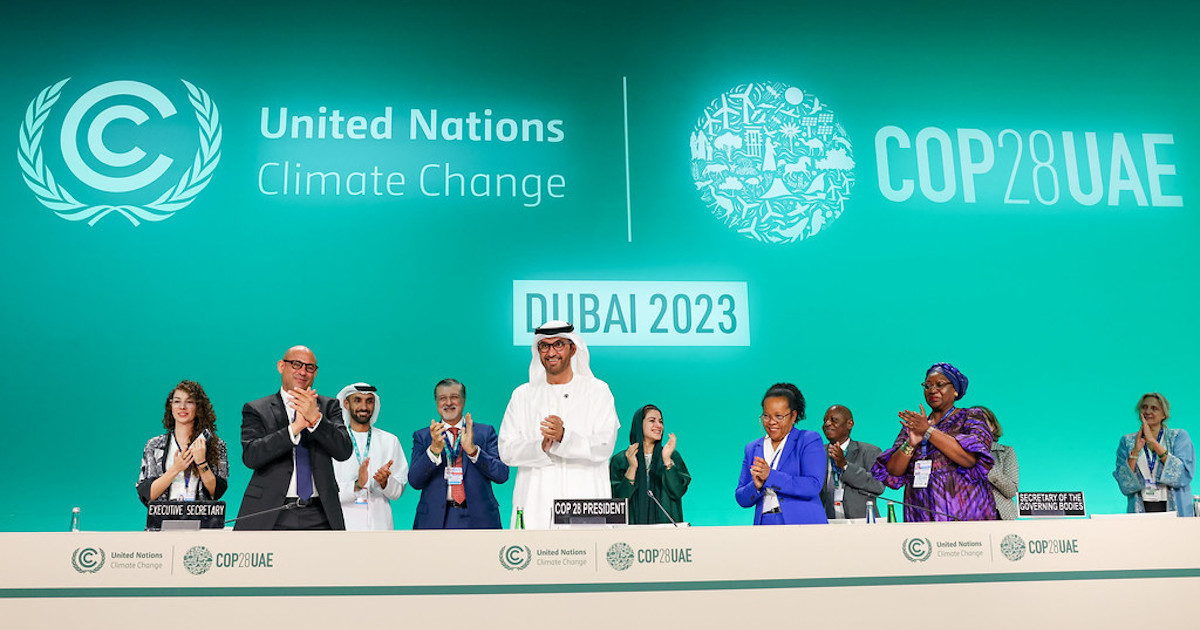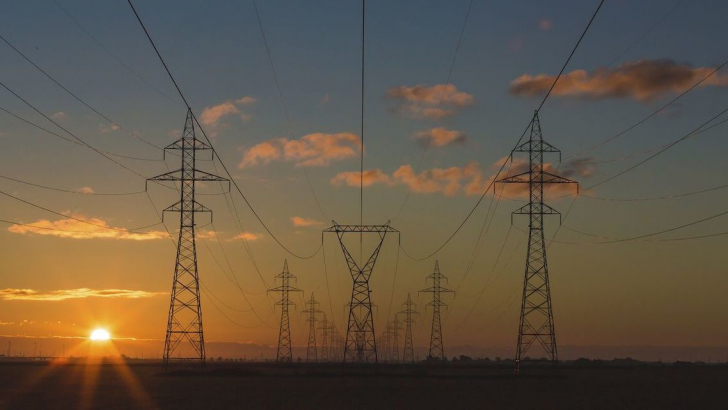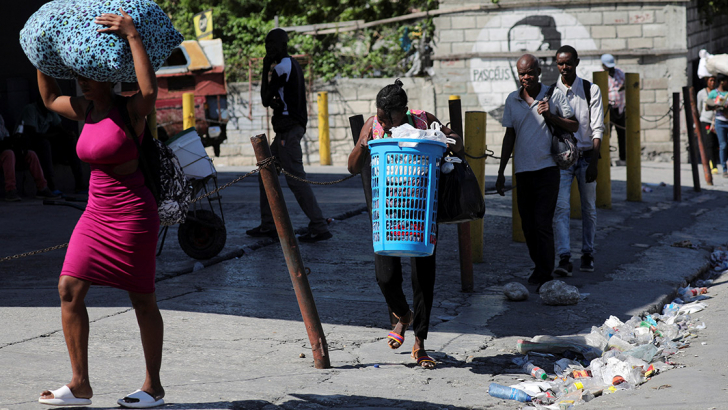
The opening day of COP28 in Dubai. Flickr
The Paris Agreement is an international treaty designed to unite member states of the United Nations in keeping global warming below the critical threshold of 2°C compared to pre-industrial levels, ideally aiming for under 1.5°C. But how is it put into practice?
The Global Stocktake, as outlined in Article 14 of the agreement, is the main mechanism established for this implementation. Literally meaning “global inventory,” it serves to take stock of the progress of climate policies and recalibrate national action plans, or NDCs (Nationally Determined Contributions) that countries are required to update and submit every 5 years.
At COP28 in Dubai, delegates are working on the third and final phase of the Global Stocktake (GST), which is the most political and delicate one. During this phase, parties have to decide on the specific wording to be included in the document for final approval. The second phase, which began in June 2022 and concluded last September, was more technical and ended with the publication of a synthesis report aiming to assess and summarise global progress since the signing of the Paris Agreement at COP21 in 2015.
The initial phase, which commenced right after COP26 in Glasgow, was centred around data collection, and called for member countries to submit their climate action plans. These plans should include an inventory of emissions produced, objectives for mitigating these emissions in the medium term (by 2030) and long term (by 2050), as well as adaptation strategies.
We know, however, that the plans presented by countries are not all equal or sufficiently ambitious. Some countries have set climate targets, such as Europe’s pledge to achieving climate neutrality by 2050, but a limited number have outlined realistic pathways to achieve them. Overall, compared to previous estimates, current projections for future emissions have slightly decreased, signalling some progress. However, projected emissions still remain too high and far from achieving warming below 1.5°C. In fact, the world is currently on track to warm by over 2,5°C by the end of the century. With these premises, the targets set by the Paris Agreement are at risk of not being met.
Every year, several reports remind us how far off course we are from the path we should be on, and the conclusions from the GST synthesis report, while not new, only confirm this reality. However, the GST is not merely a review or assessment of the tasks carried out by UNFCCC member states (United Nations Framework Convention on Climate Change). It aims instead to be the implementation tool of the Paris Agreement through what has been termed as the ‘incremental ambition mechanism,’ tracking progress made to date laying the groundwork for subsequent actions.
As Carbon Brief explains, the mechanism has also been called ‘ratchet mechanism.’ ‘Ratchet’ refers to the locking tooth in a ratchet mechanism; once the key is turned, the locking tooth prevents the reverse movement from losing the progress made, allowing the handle to move back and load the next turn.
In practical terms, the GST operates with long-term goals, monitoring the progress made towards achieving these goals, and based on these assessments, updating climate action plans in preparation for the objectives. It operates in 5-year cycles. After 2015, the first round of national action plans was collected, which officially became NDCs at COP26 in Glasgow, initially scheduled for 2020 but held in 2021 due to the Covid pandemic. In 2021, the Paris Agreement was enforced, replacing the Kyoto protocol. After the Glasgow meeting, countries were asked to draft new updated plans, which are expected to be delivered and transformed new NDCs at COP30, in 2025. From there, another 5-year cycle will begin, following the same pattern.
This process may seem extremely cumbersome, and the timelines paradoxically lengthy, given that one of the conclusions of the GST synthesis report argues that “there is a rapidly narrowing window to raise ambition and implement existing commitments in order to limit warming to 1.5 °C above pre-industrial levels.”
We should also remember that to coordinate 196 countries, which represent the entire global community with all its diversities and complexities, is not an easy task. The volume of documents to be included into the GST amounts to 170,000 pages.
Like it or not, this is what the Paris Agreement requires, and this is the common ground that representatives of the wide diversity of human societies have managed to agree upon at climate COPs. Alternatives that replace this gargantuan procedure does not exist to date. We are all in the same boat, and, in Dubai, delegates are discussing on the direction in which to steer.
This is the most political phase, as we mentioned, where delegates debate on the exact terminologies to be included in the final document. The most debated one concerns the abandonment or gradual reduction (‘phase out’ or ‘phase down’) of fossil fuels. So far, only drafts are available, and the one updated as of December 5, 2023, presents various options and parentheses at each paragraph, which represent different perspectives of different stakeholders. By the end of the meeting, these alternatives will need to be consolidated into a unified document to be adopted and approved.
It is expected that there will be mentions of objectives to triple renewable energy and double energy efficiency by 2030. Developing countries would hope for more ambitious goals in adaptation and more references to losses and damages. They also advocate for explicit references to the historical responsibilities of industrialised countries. Consequently, climate finance targets, as defined based on the principle of climate justice, should be tailored to the actual needs of vulnerable countries rather than being tied to arbitrary figures such as the $100 billion per year agreed upon at the 2009 COP15 in Copenhagen.
The Global South also wants to explicitly state that industrialised countries have so far fallen short of meeting their climate commitments. These countries, however, emphasise the importance of looking forward and advocate for wording that “encourages major emitters to significantly increase their climate ambitions:”
Until now, any explicit reference to the phase-out of fossil fuels has always been rejected at the final approval in previous COPs. However, the pressures surrounding the current COP president, Sultan Al-Jaber, has put a permanent spotlight on the issue, making it impossible to ignore.
Even accepting the phase-out of fossil fuels, oil and gas producers may resort to an expedient, namely the inclusion of the term ‘unabated.’ This term would imply that only fossil fuels whose emissions are not abated by carbon capture and storage (CCS) technologies should be abandoned. Oil and Gas companies tend to heavily rely on these systems, but according to Fatih Birol, director of the IEA (International Energy Agency), these technologies constitute a false promise.
“It is pointless to have endless debates on phase-down or phase-out,” succinctly stated scientist Johan Rockström, director of the Potsdam Institute for Climate Impact Research in Germany. “We need a text that outlines traceable, specific, and science-based paths for reducing emissions in the coming decades.” He seems to be suggesting that while words are important, they are not sufficient.
Meanwhile, in Dubai an agreement lacks even on where next year’s conference, COP29, will be held. It would be the turn of an Eastern European country: it should have been Sofia, in Bulgaria, but Putin vetoed this proposal because he does not believe that an Eastern European country would be impartial towards Russia. If an agreement was not to be found, the designed city to host the next meeting would be Bonn, Germany, where the UNFCCC is based. However, by statute, the presidency would remain the same as this year’s, held by Sultan Al-Jaber from the United Arab Emirates.
This year in Dubai, delegates representing the fossil fuel industry were 2,456, a number that is more than four times higher than the record set last year at Cop 27 in Sharm el-Sheikh, where there were just over 600 fossil fuel delegates. It remains to be seen if Al-Jaber, should he chair the next meeting, will once again break the attendance record set this year.
This article was translated into English by Sofia Belardinelli. The original version of this article is available here.
ALSO READ:




